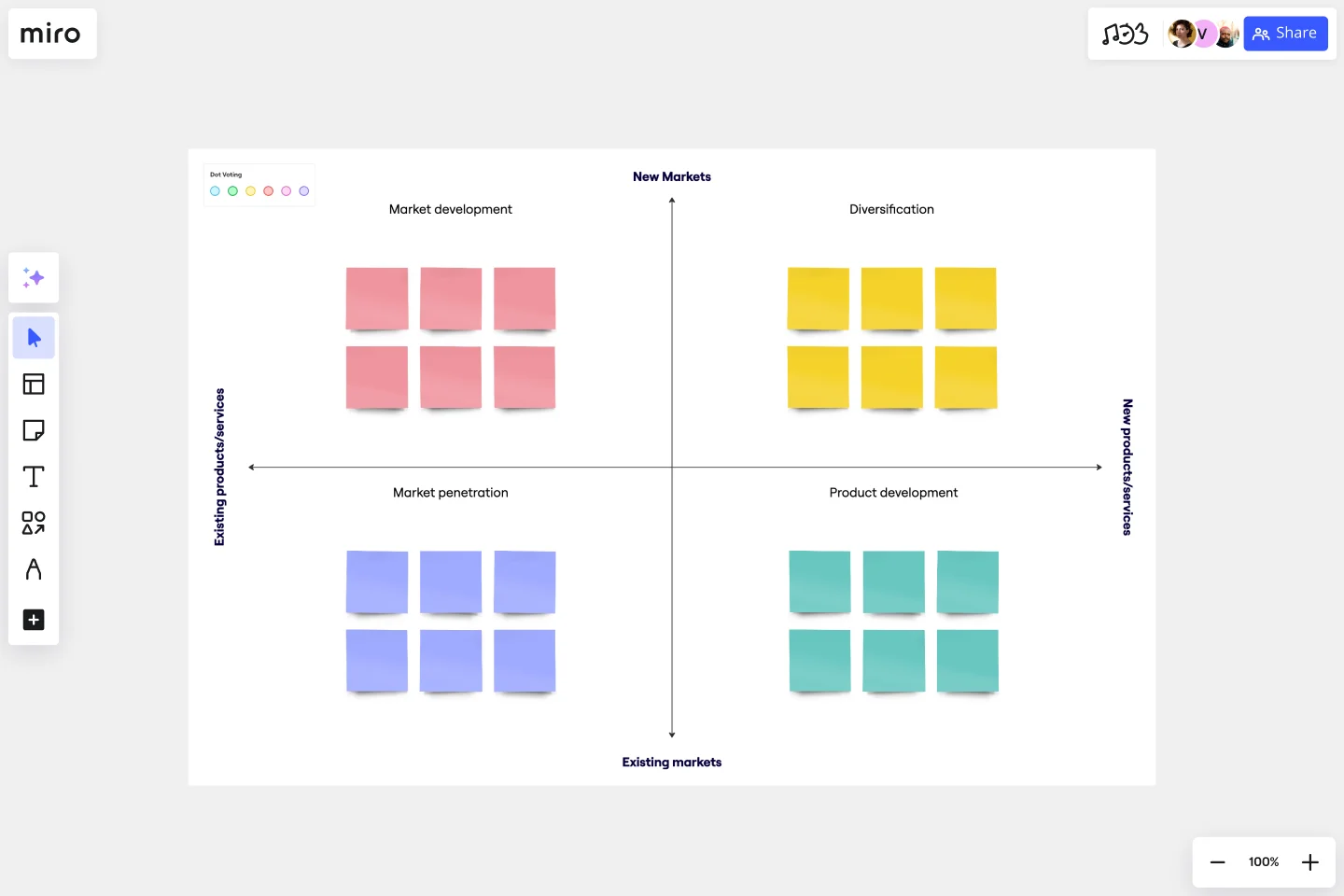Ansoff Matrix Template
Explore opportunities for growing your business with the Ansoff Matrix Template.
About the Ansoff Matrix template
When your business is doing well, it can be easy to slip into complacency. But if your organization is to keep growing and scaling, you’ll have to look for new ways to boost your bottom line and reach new customers. The Ansoff Matrix, also known as the product or market expansion grid, can help you do just that.
An Ansoff Matrix is a strategic tool that allows you to evaluate numerous options for growing your business. It helps you evaluate the potential risks of each option and to devise a plan that fits your specific organization. Igor Ansoff developed the matrix in 1957, and since then, numerous business leaders have used it to jumpstart their business’s growth.
While there are some variations, the typical Ansoff Grid contains four quadrants. Each quadrant contains a potential growth strategy. Whenever you move into a new quadrant, either horizontally or vertically, your risk increases.
How do you use the Ansoff Matrix?
The Ansoff Matrix is divided into four sections that place markets and products/services depending on whether they already exist or represent a future opportunity. The four sections are market penetration, market development, product development, and diversification. Market penetration refers to selling more of your products and services to existing customers, market development refers to entering new markets, product development refers to developing your existing products or services, and diversification refers to moving into new markets with new products and services, increasing sales with your existing customer base, and acquisition. Go through each section with your team and determine where there are areas for making changes or improvements.
When should you use the Ansoff Matrix?
You should use the Ansoff Matrix whenever you do strategic planning for your marketing organization. You may find it beneficial to fill out the matrix at least once a year, though potentially more frequently if conditions are changing rapidly in your industry.
What factors go into an Ansoff Matrix?
Factor 1 - Market penetration. The lower left quadrant contains the safest of the four options. Market penetration focuses on boosting sales of your product in your existing market. This is a low-risk option because you already know the market and you’re aware of your product’s strengths and weaknesses relative to your competitors.
Factor 2 - Product development. The lower right quadrant is slightly more risky. In this approach, you’re introducing a new product into your existing market.
Factor 3 - Market development. The upper left quadrant is even riskier. In this case, you’re launching an existing product in a new market. This strategy involves either finding a new use case for your product or adding features so that it meets a different customer need.
Factor 4 - Diversification. The upper right quadrant contains the riskiest option. You’re introducing a new product into a new market.
Get started with this template right now.
IT Project Timeline
Works best for:
Timeline, Planning
The IT Project Time Line template is essential for managing IT projects efficiently. It allows you to visualize project milestones, deadlines, and key tasks in a clear, chronological format. Track progress, allocate resources, and ensure timely delivery of your IT projects. Ideal for project managers and IT teams aiming to stay organized and meet critical deadlines.
RACI Matrix Template
Works best for:
Leadership, Decision Making, Org Charts
The RACI Matrix is an essential management tool that helps teams keep track of roles and responsibilities and can avoid confusion during projects. The acronym RACI stands for Responsible (the person who does the work to achieve the task and is responsible for getting the work done or decision made); Accountable (the person who is accountable for the correct and thorough completion of the task); Consulted (the people who provide information for the project and with whom there is two-way communication); Informed (the people who are kept informed of progress and with whom there is one-way communication).
Goal Setting Template
Works best for:
Strategic Planning
The Goal Setting Template simplifies the process and fosters strategic thinking. It includes key fields such as goal articulation, rationale, action steps, and blockers. This promotes accountability with a "Date Started" field and a clear deadline. The template turns aspirations into actionable plans with a heightened sense of accountability.
8 Different Ways to Organize Your Backlog
Works best for:
Agile
Explore 8 different techniques for managing and prioritizing work effectively with this template. From prioritization matrices to story mapping, it offers a comprehensive overview of backlog management strategies. By understanding the strengths and limitations of each approach, teams can tailor their backlog organization to optimize workflow, empowering teams to stay organized and focused on delivering value.
Feature Planning Template
Works best for:
Desk Research, Agile Methodology, Product Management
Features are what make a product or service fun, but adding new ones is no walk in the park. It takes many steps—ideating, designing, refining, building, testing, launching, and promoting—and just as many stakeholders. Feature Planning lets you put a smooth, sturdy process in place, so you can add a feature successfully, and spend less time and resources doing it. That makes our Feature Planning Template a smart starting point for anyone looking to add new product features, especially members of product, engineering, marketing, and sales teams.
Mandala Chart Template
Works best for:
Planning, Brainstorming, Goal setting
The Mandala Chart Template helps you visualize the relationships between a central theme and its sub-themes. One of the key benefits is how it fosters a holistic understanding of any topic. This perspective ensures every detail is noticed, making it an invaluable asset for those aiming for comprehensive insight and thorough planning or a better understanding of their goals.
